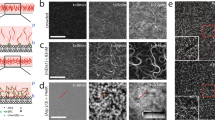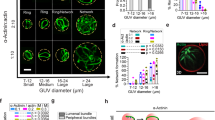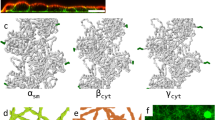Abstract
Actin plays crucial parts in cell motility through a dynamic process driven by polymerization and depolymerization, that is, the globular (G) to fibrous (F) actin transition. Although our knowledge about the actin-based cellular functions and the molecules that regulate the G- to F-actin transition is growing, the structural aspects of the transition remain enigmatic. We created a model of F-actin using X-ray fibre diffraction intensities obtained from well oriented sols of rabbit skeletal muscle F-actin to 3.3 Å in the radial direction and 5.6 Å along the equator. Here we show that the G- to F-actin conformational transition is a simple relative rotation of the two major domains by about 20 degrees. As a result of the domain rotation, the actin molecule in the filament is flat. The flat form is essential for the formation of stable, helical F-actin. Our F-actin structure model provides the basis for understanding actin polymerization as well as its molecular interactions with actin-binding proteins.
This is a preview of subscription content, access via your institution
Access options
Subscribe to this journal
Receive 51 print issues and online access
$199.00 per year
only $3.90 per issue
Buy this article
- Purchase on Springer Link
- Instant access to full article PDF
Prices may be subject to local taxes which are calculated during checkout




Similar content being viewed by others
References
Straub, F. B. in Studies Int med Chem Univ Szeged (ed Szent-Györgi) 2, 3–15 (Karger, 1942)
Pollard, T. D. & Borisy, G. G. Cellular motility driven by assembly and disassembly of actin filaments. Cell 112, 453–465 (2003)
Carlier, M. F. & Pantaloni, D. Control of actin assembly dynamics in cell motility. J. Biol. Chem. 282, 23005–23009 (2007)
Oosawa, F. & Asakura, S. Thernodynamics of the Polymerization of Protein (Academic, 1975)
Wegner, A. Head to tail polymerization of actin. J. Mol. Biol. 108, 139–150 (1976)
Kabsch, W. et al. Atomic structure of the actin:DNase I complex. Nature 347, 37–44 (1990)
Holmes, K. C., Popp, D., Gebhard, W. & Kabsch, W. Atomic model of the actin filament. Nature 347, 44–49 (1990)
Lorenz, M., Popp, D. & Holmes, K. C. Refinement of the F-actin model against X-ray fiber diffraction data by the use of a directed mutation algorithm. J. Mol. Biol. 234, 826–836 (1993)
Tirion, M. M., ben-Avraham, D., Lorenz, M. & Holmes, K. C. Normal modes as refinement parameters for the F-actin model. Biophys. J. 68, 5–12 (1995)
Holmes, K. C. et al. Electron cryo-microscopy shows how strong binding of myosin to actin releases nucleotide. Nature 425, 423–427 (2003)
Wu, Y. & Ma, J. Refinement of F-actin model against fiber diffraction data by long-range normal modes. Biophys. J. 86, 116–124 (2004)
Oda, T. et al. Modeling of the F-actin structure. Adv. Exp. Med. Biol. 592, 385–401 (2007)
van den Ent, F., Amos, L. A. & Löwe, J. Prokaryotic origin of the actin cytoskeleton. Nature 413, 39–44 (2001)
Joel, P. B., Fagnant, P. M. & Trybus, K. M. Expression of a nonpolymerizable actin mutant in Sf9 cells. Biochemistry 43, 11554–11559 (2004)
Wertman, K. F., Drubin, D. G. & Botstein, D. Systematic mutational analysis of the yeast ACT1 gene. Genetics 132, 337–350 (1992)
Allingham, J. S., Klenchin, V. A. & Rayment, I. Actin-targeting natural products: structures, properties and mechanisms of action. Cell. Mol. Life Sci. 63, 2119–2134 (2006)
Morton, W. M., Ayscough, K. R. & McLaughlin, P. J. Latrunculin alters the actin–monomer subunit interface to prevent polymerization. Nature Cell Biol. 2, 376–378 (2000)
Oda, T. et al. Effect of the length and effective diameter of F-actin on the filament orientation in liquid crystalline sols measured by x-ray fiber diffraction. Biophys. J. 75, 2672–2681 (1998)
Hayward, S. & Berendsen, H. J. Systematic analysis of domain motions in proteins from conformational change: new results on citrate synthase and T4 lysozyme. Proteins 30, 144–154 (1998)
Otterbein, L. R., Graceffa, P. & Dominguez, R. The crystal structure of uncomplexed actin in the ADP state. Science 293, 708–711 (2001)
Michie, K. A. & Löwe, J. Dynamic filaments of the bacterial cytoskeleton. Annu. Rev. Biochem. 75, 467–492 (2006)
Carballido-Lopez, R. The bacterial actin-like cytoskeleton. Microbiol. Mol. Biol. Rev. 70, 888–909 (2006)
Chen, X., Cook, R. K. & Rubenstein, P. A. Yeast actin with a mutation in the “hydrophobic plug” between subdomains 3 and 4 (L266D) displays a cold-sensitive polymerization defect. J. Cell Biol. 123, 1185–1195 (1993)
Volkmann, N. et al. The structural basis of myosin V processive movement as revealed by electron cryomicroscopy. Mol. Cell 19, 595–605 (2005)
Rould, M. A. et al. Crystal structures of expressed non-polymerizable monomeric actin in the ADP and ATP states. J. Biol. Chem. 281, 31909–31919 (2006)
Nolen, B. J. & Pollard, T. D. Insights into the influence of nucleotides on actin family proteins from seven structures of Arp2/3 complex. Mol. Cell 26, 449–457 (2007)
Graceffa, P. & Dominguez, R. Crystal structure of monomeric actin in the ATP state. Structural basis of nucleotide-dependent actin dynamics. J. Biol. Chem. 278, 34172–34180 (2003)
Robinson, R. C. et al. Crystal structure of Arp2/3 complex. Science 294, 1679–1684 (2001)
De La Cruz, E. M. et al. Polymerization and structure of nucleotide-free actin filaments. J. Mol. Biol. 295, 517–526 (2000)
Pollard, T. D. Regulation of actin filament assembly by Arp2/3 complex and formins. Annu. Rev. Biophys. Biomol. Struct. 36, 451–477 (2007)
Iwasa, M. et al. Dual roles of Q137 of actin revealed by recombinant human cardiac muscle alpha -actin mutants. J. Biol. Chem. 283, 21045–21053 (2008)
Vorobiev, S. et al. The structure of nonvertebrate actin: implications for the ATP hydrolytic mechanism. Proc. Natl Acad. Sci. USA 100, 5760–5765 (2003)
Vogel, M., Bukau, B. & Mayer, M. P. Allosteric regulation of Hsp70 chaperones by a proline switch. Mol. Cell 21, 359–367 (2006)
Yao, X., Nguyen, V., Wriggers, W. & Rubenstein, P. A. Regulation of yeast actin behavior by interaction of charged residues across the interdomain cleft. J. Biol. Chem. 277, 22875–22882 (2002)
Nyman, T. et al. The role of MeH73 in actin polymerization and ATP hydrolysis. J. Mol. Biol. 317, 577–589 (2002)
Otomo, T. et al. Structural basis of actin filament nucleation and processive capping by a formin homology 2 domain. Nature 433, 488–494 (2005)
Furuhashi, K. et al. Phosphorylation by actin kinase of the pointed end domain on the actin molecule. J. Biol. Chem. 267, 9326–9330 (1992)
Klenchin, V. A., Khaitlina, S. Y. & Rayment, I. Crystal structure of polymerization-competent actin. J. Mol. Biol. 362, 140–150 (2006)
Dalhaimer, P., Pollard, T. D. & Nolen, B. J. Nucleotide-mediated conformational changes of monomeric actin and Arp3 studied by molecular dynamics simulations. J. Mol. Biol. 376, 166–183 (2008)
Ravelli, R. B. et al. Insight into tubulin regulation from a complex with colchicine and a stathmin-like domain. Nature 428, 198–202 (2004)
Wang, H. W. & Nogales, E. Nucleotide-dependent bending flexibility of tubulin regulates microtubule assembly. Nature 435, 911–915 (2005)
Wang, H. & Stubbs, G. Molecular dynamics in refinement against fiber diffraction data. Acta Crystallogr. A 49, 504–513 (1993)
Narita, A. & Maeda, Y. Molecular determination by electron microscopy of the actin filament end structure. J. Mol. Biol. 365, 480–501 (2007)
Narita, A., Takeda, S., Yamashita, A. & Maeda, Y. Structural basis of actin filament capping at the barbed-end: a cryo-electron microscopy study. EMBO J. 25, 5626–5633 (2006)
Kraulis, J. MOLSCRIPT: a program to produce both detailed and schematic plots of protein structures. J. Appl. Cryst. 24, 946–950 (1991)
Esnouf, R. M. An extensively modified version of MolScript that includes greatly enhanced coloring capabilities. J. Mol. Graph. Model. 15, 132–134 (1997)
Merritt, E. A. & Bacon, D. J. Raster3D: photorealistic molecular graphics. Methods Enzymol. 277, 505–524 (1997)
Kudryashov, D. S. et al. The crystal structure of a cross-linked actin dimer suggests a detailed molecular interface in F-actin. Proc. Natl Acad. Sci. USA 102, 13105–13110 (2005)
Allingham, J. S., Zampella, A., D’Auria, M. V. & Rayment, I. Structures of microfilament destabilizing toxins bound to actin provide insight into toxin design and activity. Proc. Natl Acad. Sci. USA 102, 14527–14532 (2005)
Rizvi, S. A., Tereshko, V., Kossiakoff, A. A. & Kozmin, S. A. Structure of bistramide A-actin complex at a 1.35 angstroms resolution. J. Am. Chem. Soc. 128, 3882–3883 (2006)
Acknowledgements
We thank K. C. Holmes for continuous encouragement and D. Hanein for the gift of the atomic coordinates of the Volkmann et al. model (ref. 24). We thank K. Namba, K. Makino and K. Hasegwa for comments on the manuscript, the gift of software package for the fibre analysis and help with recording the diffraction patterns. We also thank S. Fujiwara and K. Mihashi for comments on the manuscript. We finally thank beam-line staffs at SPring-8 BL40B2, BL41XU and BL45XU-SAX, especially M. Kawamoto and K. Ito. The electron microscopy section of this study is partially supported by the Kazato Research Foundation (A.N.).
Author Contributions The X-ray fibre diffraction analysis for F-actin structure was performed by T.O. The mutant analysis of actin was conducted by M.I. and T.A. The structural analysis for the F-actin structure by the use of the electron cryomicroscopy analysis was conducted by A.N. Manuscript preparation was done by T.O. together with Y.M.
Author information
Authors and Affiliations
Corresponding author
Supplementary information
Supplementary Information
This file contains Supplementary Figures 1-9 with Legends, and Supplementary References, Supplementary Methods with Supplementary Methods Figures 1-5 with Legends and Supplementary Methods References. (PDF 2452 kb)
Atomic coordinates 1
This file contains the atomic coordinates 1-monomer.pdb (TXT 159 kb)
Atomic coordinates 2
This file contains the atomic coordinates 3- monomer.pdb (TXT 477 kb)
Supplementary Video 1
Supplementary Video 1 shows comparison of our F-actin model and the Holmes 2003 model with the EM map. (See nature07685-s1 for full movie legend). (MOV 4209 kb)
Supplementary Video 2
Supplementary Video 2 shows comparison of our F-actin model and the Volkmann model with the EM map.(See nature07685-s1 for full movie legend). (MOV 4406 kb)
Rights and permissions
About this article
Cite this article
Oda, T., Iwasa, M., Aihara, T. et al. The nature of the globular- to fibrous-actin transition. Nature 457, 441–445 (2009). https://doi.org/10.1038/nature07685
Received:
Accepted:
Issue Date:
DOI: https://doi.org/10.1038/nature07685
This article is cited by
-
Vascular endothelial growth factor induces the migration of human airway smooth muscle cells by activating the RhoA/ROCK pathway
BMC Pulmonary Medicine (2023)
-
Magic angle spinning NMR structure of human cofilin-2 assembled on actin filaments reveals isoform-specific conformation and binding mode
Nature Communications (2022)
-
Bound nucleotide can control the dynamic architecture of monomeric actin
Nature Structural & Molecular Biology (2022)
-
Bending forces and nucleotide state jointly regulate F-actin structure
Nature (2022)
-
Biochemical and mechanical regulation of actin dynamics
Nature Reviews Molecular Cell Biology (2022)
Comments
By submitting a comment you agree to abide by our Terms and Community Guidelines. If you find something abusive or that does not comply with our terms or guidelines please flag it as inappropriate.



